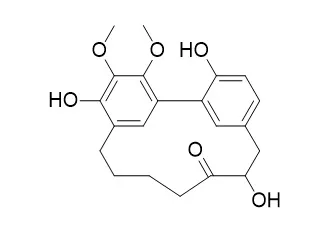| In vitro: |
| Phytochemistry. 2014 Jul;103:89-98. | | Biological evaluation of secondary metabolites from the roots of Myrica adenophora.[Pubmed: 24810013] |
METHODS AND RESULTS:
Bioassay-guided fractionation of the roots of Myrica adenophora led to isolation of 24 known compounds and hitherto unknown compounds, including three A-type proanthocyanidins [adenodimerins A-C], two esters of sucrose [myricadenins A and B ], and the phenolic glycoside 6'-O-galloyl orbicularin. Spectroscopic analyses were used to determine their structures. Adenodimerin A, myricananin C, and myricetin showed strong 1,1-diphenyl-2-picrylhydrazyl (DPPH) radical scavenging activities, with SC50 values of 7.9, 16.3, and 15.9 μM, respectively. Adenodimerin A, myricanone, myricananin C, (-)-myricanol, myricanol 11-O-β-D-glucopyranoside, and myricetin showed stronger 2,2'-azino-bis-3-ethylbenzthiazoline-6-sulphonic acid (ABTS) radical scavenging activities than the positive control, with SC50 values of 7.5, 19.6, 12.0, 22.3, 19.6, and 15.6 μM, respectively.
CONCLUSIONS:
5-Deoxymyricanone, porson, 12-Hydroxymyricanone (-)-myricanol, and (+)-galeon exhibited anti-tubercular activity against
Mycobacterium tuberculosis H37Rv in vitro and MICs values of 25.8, 40.0, 35.8, 30.0, and 15.0 μg/mL, respectively. Myricadenin A, myricanone, myricananin C, and (-)-myricanol exhibited anti-inflammatory activities in the iNOS assay with EC50 values of 18.1, 1.00, 13.0, and 7.5 μM, respectively. | | Bioorg Med Chem. 2008 Sep 15;16(18):8510-5. | | Cyclic diarylheptanoids from Myrica nana inhibiting nitric oxide release.[Pubmed: 18723353 ] |
METHODS AND RESULTS:
Investigation of the roots of Myrica nana afforded five new cyclic diarylheptanoids, myricananins A-E (1-5), two new artifacts of myricananins A and B (6-7), and four known compounds, 12-Hydroxymyricanone (8), alnusonol (9), myricatomentogenin (10), and actinidione (11). The structures of these new compounds were established by detailed spectroscopic methods. The stereochemistry of compounds 1 and 2 were determined by single-crystal X-ray diffraction. In exception of compounds 2, 6 and 10, all the other compounds were examined for their inhibitory effects on nitric oxide production in lipopolysaccharides-activated macrophages.
CONCLUSIONS:
Compounds 1, 3, 7, 8 and 9 inhibited the release of nitric oxide with IC(50) values of 45.32, 63.51, 52.81, 30.19 and 46.18muM, respectively. Furthermore, compound 1 was found to inhibit the expression of inducible nitric oxide synthase. |
|






 Cell. 2018 Jan 11;172(1-2):249-261.e12. doi: 10.1016/j.cell.2017.12.019.IF=36.216(2019)
Cell. 2018 Jan 11;172(1-2):249-261.e12. doi: 10.1016/j.cell.2017.12.019.IF=36.216(2019) Cell Metab. 2020 Mar 3;31(3):534-548.e5. doi: 10.1016/j.cmet.2020.01.002.IF=22.415(2019)
Cell Metab. 2020 Mar 3;31(3):534-548.e5. doi: 10.1016/j.cmet.2020.01.002.IF=22.415(2019) Mol Cell. 2017 Nov 16;68(4):673-685.e6. doi: 10.1016/j.molcel.2017.10.022.IF=14.548(2019)
Mol Cell. 2017 Nov 16;68(4):673-685.e6. doi: 10.1016/j.molcel.2017.10.022.IF=14.548(2019)